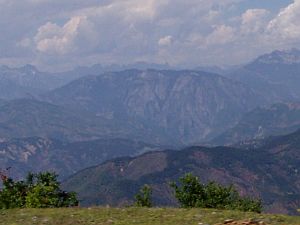Albania's Topography, Nature & Climate

| ||
| Mountains clearly dominate Albania's landscape |
Although Albania is a rather small country, it's hard to believe how small it really is - mountains dominate almost the entire country, which means that it takes many hours to travel around 100 km only when going from East to West for example. This of course is also due to the lack of tunnels and poor roads in some areas. Things look different along the coastline of course. The North, South and East of the country is characterized by the Dinaric Alps, which can be separated into the Bjeshkët e Namuna (also: Albanian Alps) in the Northeast, some smaller mountain ranges in the central part of Eastern Albania and the Epirus Mountains on both sides of the Albanian-Greek border in the South. All of those mountain ranges are rather rugged and have countless summits higher then 2,000 meters. The highest summit of Albania is the 2,764 m high Maja e Korabit (in Macedonian: Golem Korab), right on the border to →Macedonia. In Western Albania, along the roughly 350 km long Adriatic Sea coastline, stretches a 200 km, but maximum 60 km wide plain, partially occupied by swamps and lagoons.
Albania's topography allows hydroelectic power generation. For this reason, the river Drin (among others) is being retained in wide parts. The Drinit të Zi (Black Drin) comes from →Lake Ohrid; the Drinit të bardhë (White Drin) from →Montenegro. They join near →Kukës, where one of the large dams along the river Drin starts. Together with most other Albanian rivers, the river Drin empties into the Adriatic Sea. Albania has its share of all of the three biggest lakes on the Balkan peninsula - as there are the →Liqeni i Shkodrës (Lake Shkodra, also: Lake Skutari) in the Northwest and Liqeni i Ohrit & Liqeni i Prespa (Lake Prespa and Lake Ohrid, see →Ohrid) in central Eastern Albania.
Around one third of the country is covered by forests - that is mainly the area between the main mountain ridge and the coastline. The climate is rather mediterranean along the coast, which means hot summers and mild winters with the precipitation peak in winter. Eastwards, the climate gets rather continental. Needless to say that it gets much colder in higher areas - snow and frost are very common in the Albanian mountains.
©2024 Europe-East.com

 Albania
Albania Armenia
Armenia